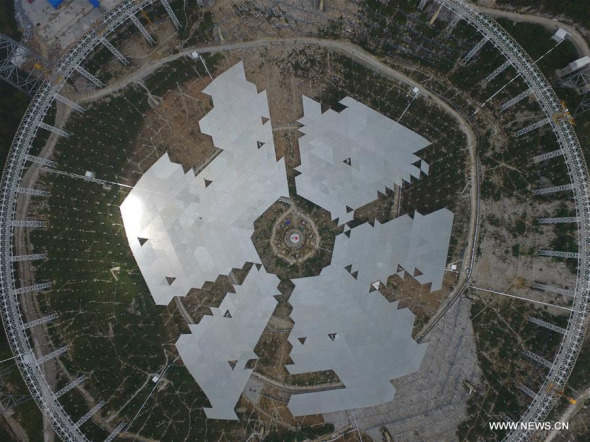
The feed cabin supporting system of China's single-aperture spherical telescope "FAST" is under test in Qiannan of southwest China's Guizhou Province, Nov. 21, 2015. When it is completed in 2016, the five hundred meter aperture spherical telescope (FAST) will be the world's largest, overtaking Puerto Rico's Arecibo Observatory, which is 300 meters in diameter. (Photo: Xinhua/Jin Liwang)
Chinese scientists on Saturday tested the installation of the "retina" of the world's largest ever radio telescope to be completed in September next year.
Technicians lifted a 30-tonne feed cabin of the Five hundred meter Aperture Spherical Telescope - or FAST - above a half-finished dish-like reflector measuring 500 meters in diameter and 1.6 kilometers in perimeter.
Once completed, the cabin, home to a feed source which collects signals from the universe, will be suspended 140 to 160 meters above the reflector made up of 4,450 panels.
Each panel is an equilateral triangle with a side length of 11 meters, and has cables fixed to the back of it so that it could adjust angles and positions in synchronization with the source cabin, which is driven by cables, servomechanisms in additional to a parallel robot as a secondary adjustable system.
"If you compare the FAST to an eye, then the feed source is its retina," said Sun Caihong, a chief engineer with the FAST program, "All signals we collect eventually comes here."
Sun said control of high-precision and long-distance movements of the source cabin using steel cables had been a serious challenge for experts, but they managed to narrow down maximum error to less then 10 millimeters.
"This is one of our greatest innovations," he said.
Construction of the FAST began in March 2011 with an investment of 1.2 billion yuan.
The installation of the test feed cabin means the construction of FAST has enter its final stage.
Technicians are still continuing the work that started months ago to assemble the reflector, which is hung over the ground supported by thousands of steel pillars and cables in a valley deep in southwest China's mountainous Guizhou Province.
The Karst formation in the local landscape is good for draining rainwater underground and protecting the reflector, Sun said.
The surrounding area has "radio silence" as there are no towns and cities within a sphere of five km and only one county center within a sphere of 25 km, he said.
Upon completion, the telescope will be the world's largest of its kind, overtaking Puerto Rico's Arecibo Observatory, which is 300 meters in diameter.
It will also be 10 times more sensitive than the steerable 100-meter telescope near Bonn, Germany, according to Zheng Xiaonian, deputy head of the National Astronomical Observatories under the Chinese Academy of Sciences.
"FAST will be the top level facility in the world for at least 20 to 30 years," Zheng said.
Unlike optical telescopes used to observe the universe by visible light, a type of electromagnetic radiation, radio telescope operate in the radio frequency portion of the electromagnetic spectrum where they can detect and collect data on radio sources.
The key science goals of FAST are based on observables between 70MHz and 3 GHz, including the 21 cm HI hyperfine structure line, pulsar emissions and radio continuum.
Earlier reports said it will enable astronomers to jumpstart many science goals. For example, they could survey natural hydrogen in distant galaxies, detect faint pulsars, look for the first star shining, or even hear possible signals from other civilizations.


















































